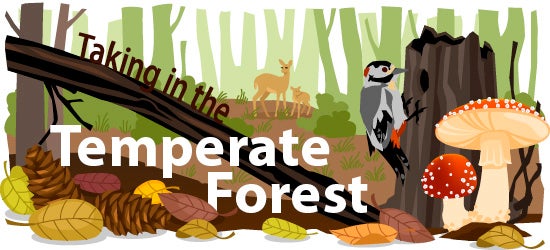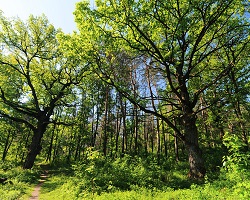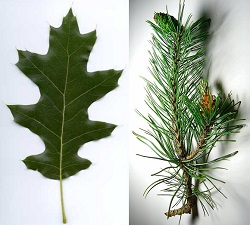
Illustrated by: Sabine Deviche
The air is still as you wander through the trees. Leaves slide under your feet and thick tree trunks surround you. Above your head everything is green, as leaves block the sky. You feel twigs crunch under your feet, and mushrooms peek out from under beds of leaves. Somewhere off in the trees you hear the pecking of a woodpecker. All sorts of birds call or fly off as you walk by. You stay quiet and see a deer pass by in the distance. Chances are, you’re in a temperate forest.

Even if you've spent time in temperate forests, these ecosystems hold many plants and animals that you've likely never seen. In parts of North America, Europe, and Asia, temperate forests used to cover huge areas of land. In several places they still cover large areas, though we've cut down most of the old growth forests.
In Between Biomes
In many ways, temperate forests are in between the other land biomes. In fact, the word temperate means not extreme. They are warmer and more diverse than boreal forests. However, they are not as warm or diverse as rainforests. Temperate forests are also wetter than deserts but drier than rainforests. This is because temperate forests are located in areas that have a mild climate.
Mild climates are mainly found around the mid-latitudes. South American and Australian temperate forests have many plants and animals that are similar, but unrelated, to those in the northern hemisphere’s temperate forests. Temperate forests receive about 30 to 60 inches of precipitation a year. The temperatures are rarely below -20 F (-29 C) or above 90 F (32 C).
Changing Seasons
Temperate forests have four seasons: spring, summer, winter, and fall. Because they are in the mid latitudes of the Earth — not too far south or north — they have a mild climate.

They have warm summers that are not overly hot like in the deserts further south, during which plants and trees can grow. They also have snowy winters that are not overly cold like in the boreal forests, during which many plants are dormant and many animals migrate or hibernate.There are many ways temperate forests can be further divided, but the two main types are deciduous and coniferous forests. Deciduous forests have deciduous trees like maples, which lose their leaves in the winter. Coniferous forests are have lots of conifers like Lodgepole Pine, which keep their needles (special leaves) all year long. Generally, coniferous forests receive less rain than deciduous forests and they grow more slowly. In the United States, most western temperate forests are coniferous and most eastern temperate forests are deciduous.
Images via Wikimedia Commons. Autumn forest image by ForestWander.
Read more about: Taking in the Temperate Forest
Bibliographic details:
- Article: Taking in the Temperate Forest
- Author(s): Drew Peltier
- Publisher: Arizona State University School of Life Sciences Ask A Biologist
- Site name: ASU - Ask A Biologist
- Date published:
- Date accessed:
- Link: https://askabiologist.asu.edu/explore/temperate-forest
APA Style
Drew Peltier. (). Taking in the Temperate Forest. ASU - Ask A Biologist. Retrieved from https://askabiologist.asu.edu/explore/temperate-forest
Chicago Manual of Style
Drew Peltier. "Taking in the Temperate Forest". ASU - Ask A Biologist. . https://askabiologist.asu.edu/explore/temperate-forest
Drew Peltier. "Taking in the Temperate Forest". ASU - Ask A Biologist. . ASU - Ask A Biologist, Web. https://askabiologist.asu.edu/explore/temperate-forest
MLA 2017 Style

In deciduous temperate forests, many tree leaves change color during autumn before the trees lose their leaves in winter.
![]() Try our Virtual Biomes
Try our Virtual Biomes
Be Part of
Ask A Biologist
By volunteering, or simply sending us feedback on the site. Scientists, teachers, writers, illustrators, and translators are all important to the program. If you are interested in helping with the website we have a Volunteers page to get the process started.

